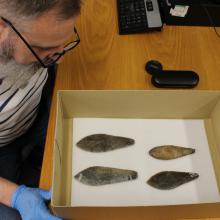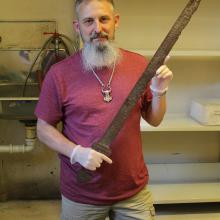
I found my first projectile point on our ranch on the High Plains of Eastern Colorado when I was eight years old thus igniting a passion that continues today. I spent 24 years in military service before retiring in 2011. During this period, I amassed countless hours involved in site excavations and laboratory work from Maryland to Oklahoma.
In 2018 I was offered the opportunity to pursue a Master’s Degree at the University of Exeter in their benchmark Experimental Archaeology program. I completed the degree in August of 2019 with a dissertation titled “Exploring the Combative Efficacy of Neolithic Flint Beaker Daggers of the British Isles”.
I have demonstrated flint knapping/lithic reduction techniques of the earliest industries to those at the height of Neolithic for school children to academic audiences. I am versed and competent in techniques from most continents/periods. However, there remains a world of lithic techniques to be explored!
Additionally, I am involved in the creation/forging of weapons and the industries involved in their creation (smelting, casting, pattern welding, inlay etc.). My interest spans Bronze Age Europe/Scandinavia thru Viking Age metal working. I have a special affinity for the single edged swords of Norway’s Viking age.
I have, and continue to participate in living history events in Scandinavia (of both prehistoric and Viking ages) as I am spending a large amount of the summers since retirement in Scandinavia and Europe.
The best advice I can give, as I hold myself to this, is to truly learn from what you do. A failure is not a failure in itself, but an answer. Was it a failure in the technique or the execution of it? We must replicate the entire process involved; from the waste to the failures seen in the record, not just the finished product. Each item has its own “recipe” and like all recipes, variation can and will occur but still can lead to the same outcome. When we accomplish this then we truly can say that we have a “possible” or “probable” interpretation. But this is only one step in the process; the items must be utilized, refurbished and monitored until discard to really see its biographical changes and the behaviors, and possibly the mindset that drove these decisions. This is the essence of experimental archaeology and why true science-based, free from bias experimentation is essential for the interpretation of our prehistoric past.




